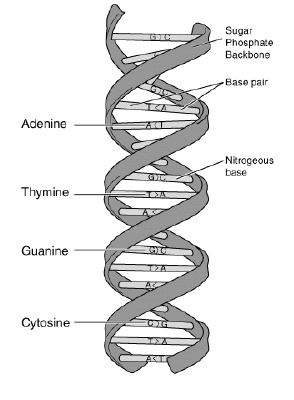原题链接:http://uva.onlinejudge.org/index.php?option=com_onlinejudge&Itemid=8&page=show_problem&problem=4114
| 13845357 | 1368 | DNA Consensus String | Accepted | C++ | 0.022 | 2014-07-07 12:29:30 |

Figure 1. DNA (Deoxyribonucleic Acid) is the molecule which contains the genetic instructions. It consists of four different nucleotides, namely Adenine, Thymine, Guanine, and Cytosine as shown in Figure 1. If we represent a nucleotide by its initial character, a DNA strand can be regarded as a long string (sequence of characters) consisting of the four characters A, T, G, and C. For example, assume we are given some part of a DNA strand which is composed of the following sequence of nucleotides:
``Thymine-Adenine-Adenine-Cytosine-Thymine-Guanine-Cytosine-Cytosine-Guanine-Adenine-Thymine"
Then we can represent the above DNA strand with the string
``TAACTGCCGAT."
The biologist Prof. Ahn found that a gene X commonly exists in the DNA
strands of five different kinds of animals, namely dogs, cats, horses,
cows, and monkeys. He also discovered that the DNA sequences of the gene
X from each animal were very alike. See Figure 2.
| DNA sequence of gene X | |
| Cat: | GCATATGGCTGTGCA |
| Dog: | GCAAATGGCTGTGCA |
| Horse: | GCTAATGGGTGTCCA |
| Cow: | GCAAATGGCTGTGCA |
| Monkey: | GCAAATCGGTGAGCA |
Figure 2. DNA sequences of gene X in five animals.
Prof. Ahn thought that humans might also have the gene X and decided to
search for the DNA sequence of X in human DNA. However, before
searching, he should define a representative DNA sequence of gene X
because its sequences are not exactly the same in the DNA of the five
animals. He decided to use the Hamming distance to define the
representative sequence.
The Hamming distance is the number of different characters at each
position from two strings of equal length.
For example, assume we are given the two strings ``AGCAT" and ``GGAAT."
The Hamming distance of these two strings is 2 because the 1st and the
3rd characters of the two strings are different. Using the Hamming
distance, we can define a representative string for a set of multiple
strings of equal length. Given a set of strings
S = s1,..., sm
of length n
, the consensus error between a string y
of length n
and the set S
is the sum of the Hamming distances between y
and each si
in S
. If the consensus error between y
and S
is the minimum among all possible strings y
of length n
, y
is called a consensus string of S
. For example, given the three strings ``AGCAT" ``AGACT" and ``GGAAT" the consensus string of the given strings is ``AGAAT" because the sum of the Hamming distances between ``AGAAT"
and the three strings is 3 which is minimal. (In this case, the
consensus string is unique, but in general, there can be more than one
consensus string.) We use the consensus string as a representative of
the DNA sequence. For the example of Figure 2 above, a consensus string
of gene X is ``GCAAATGGCTGTGCA" and the consensus error is 7.
Input
Your program is to read from standard input. The input consists of T
test cases. The number of test cases T
is given in the first line of the input. Each test case starts with a line containing two integers m
and n
which are separated by a single space. The integer m
(4![]() m
m![]() 50)
represents the number of DNA sequences and n
(4
50)
represents the number of DNA sequences and n
(4![]() n
n![]() 1000)
represents the length of the DNA sequences, respectively. In each of the next m
lines, each DNA sequence is given.
1000)
represents the length of the DNA sequences, respectively. In each of the next m
lines, each DNA sequence is given.
Output
Your program is to write to standard output. Print the consensus string in the first line of each case and the consensus error in the second line of each case. If there exists more than one consensus string, print the lexicographically smallest consensus string. The following shows sample input and output for three test cases.
Sample Input
3 5 8 TATGATAC TAAGCTAC AAAGATCC TGAGATAC TAAGATGT 4 10 ACGTACGTAC CCGTACGTAG GCGTACGTAT TCGTACGTAA 6 10 ATGTTACCAT AAGTTACGAT AACAAAGCAA AAGTTACCTT AAGTTACCAA TACTTACCAA
Sample Output
TAAGATAC 7 ACGTACGTAA 6 AAGTTACCAA 12
解题思路:题目要求就是招出Hamming距离最小的串,题目中的Hamming值就是与原来串不同字母的个数。要满足整体的Hamming最小,就将每个位置孤立出来单独考虑,然后暴力比较就好。
1 #include <iostream> 2 #include <cstring> 3 #include <cstdio> 4 #include <cstdlib> 5 #include <cctype> 6 #include <cmath> 7 #include <algorithm> 8 #include <numeric> 9 using namespace std; 10 int main() { 11 int n, len, l; cin >> l; 12 string gene[55]; 13 char TGCA[4]; 14 while(l--) { 15 cin >> n >> len; 16 int cnt = 0; 17 for(int i = 0; i < n; i++) { 18 cin >> gene[i]; 19 } 20 21 for(int i = 0; i < len; i++) { 22 memset(TGCA, 0, sizeof(TGCA)); 23 for(int j = 0; j < n; j++) { 24 if(gene[j][i] == 'T') { 25 TGCA[0] ++; 26 } else if (gene[j][i] == 'G') { 27 TGCA[1] ++; 28 } else if (gene[j][i] == 'C') { 29 TGCA[2] ++; 30 } else if (gene[j][i] == 'A') { 31 TGCA[3] ++; 32 } 33 34 } 35 36 if(TGCA[0] > TGCA[1] && TGCA[0] > TGCA[2] && TGCA[0] > TGCA[3]) { 37 cout << 'T'; 38 cnt += TGCA[1] + TGCA[2] + TGCA[3]; 39 } else if(TGCA[1] >= TGCA[0] && TGCA[1] > TGCA[2] && TGCA[1] > TGCA[3] ) { 40 cout << 'G'; 41 cnt += TGCA[0] + TGCA[2] + TGCA[3]; 42 } else if(TGCA[2] >= TGCA[0] && TGCA[2] >= TGCA[1] && TGCA[2] > TGCA[3]) { 43 cout << 'C'; 44 cnt += TGCA[1] + TGCA[0] + TGCA[3]; 45 } else if(TGCA[3] >= TGCA[0] && TGCA[3] >= TGCA[1] && TGCA[3] >= TGCA[2]) { 46 cout << 'A'; 47 cnt += TGCA[1] + TGCA[2] + TGCA[0]; 48 } 49 50 } 51 cout << endl << cnt << endl; 52 } 53 return 0; 54 }